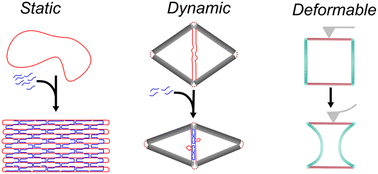Mechanics of dynamic and deformable DNA nanostructures
Abstract
In DNA nanotechnology, DNA molecules are designed, engineered, and assembled into arbitrary-shaped architectures with predesigned functions. Static DNA assemblies often have delicate designs with structural rigidity to overcome thermal fluctuations. Dynamic structures reconfigure in response to external cues, which have been explored to create functional nanodevices for environmental sensing and other applications. However, the precise control of reconfiguration dynamics has been a challenge due partly to flexible single-stranded DNA connections between moving parts. Deformable structures are special dynamic constructs with deformation on double-stranded parts and single-stranded hinges during transformation. These structures often have better control in programmed deformation. However, related deformability and mechanics including transformation mechanisms are not well understood or documented. In this review, we summarize the development of dynamic and deformable DNA nanostructures from a mechanical perspective. We present deformation mechanisms such as single-stranded DNA hinges with lock-and-release pairs, jack edges, helicity modulation, and external loading. Theoretical and computational models are discussed for understanding their associated deformations and mechanics. We elucidate the pros and cons of each model and recommend design processes based on the models. The design guidelines should be useful for those who have limited knowledge in mechanics as well as expert DNA designers.

- This article is part of the themed collection: 2023 Chemical Science Perspective & Review Collection


 Please wait while we load your content...
Please wait while we load your content...